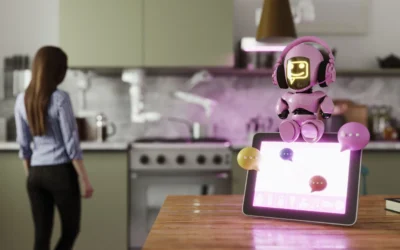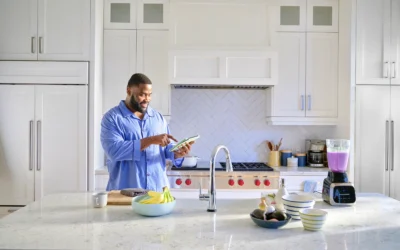Technology is at the forefront of almost everything we do, every day. We no longer live with technology. Instead, we live through it. We work, go to school, play, and socialize online. And technology is only becoming more prominent as smart devices enter our homes in the form of doorbells and thermostats. Face it. Technology isn’t going anywhere. So, how can we learn to co-exist? Or better yet, how can we learn to use technology in a way that supports our physical and mental well-being?
The answer is in digital mindfulness.
What is mindfulness anyway?
Mindfulness, by definition, is the basic human ability to be present–aware of where we are and what we’re doing without being overly reactive or overwhelmed by what’s going on around us. In everyday life, mindfulness helps us as it improves our physical and mental health and overall well-being. Meditation, for example, can be a form of mindfulness. But you don’t have to set out your meditation cushion every day to be mindful. Rather, mindfulness is innate and can merely be enhanced through conscious techniques.
Other techniques that can supplement innate mindfulness include yoga, physical exercise, positive affirmations, journaling, and therapy. They allow for a conscious connection between body and mind, and introducing them into your daily routine can help reduce stress levels, improve sleep, and improve physical health. Simply put, mindfulness activities can help mitigate the negative everyday effects your body endures.

Defining digital mindfulness
Don’t mistake digital mindfulness for taking frequent breaks from technology or disconnecting from social media for weeks on end. It’s important that we create a sustainable relationship with technology. This involves changing the mental narrative around digital devices and acknowledging that technology and mindfulness do not have to be independent from one another. A symbiotic relationship between mindfulness and the digital world allows technology to support your mental and physical health in a positive way.
The question is, how?
Be aware of your digital usage
Being mindful is simply being conscious of what you’re doing. One way to be digitally mindful is to consider how much time you spend on your device each day. Your smartphone’s screen time tracking feature is a great way to determine how much time you’re spending on your device, and whether that time is helpful or harmful. For example, if you’re on your phone an average of five hours a day, but four of those hours are spent listening to an audiobook or podcast while you’re multi-tasking, that’s much different than five hours of mindless scrolling through Facebook or Twitter. It all comes down to asking yourself if you use your device in a way that is mindless or mindful.
Be realistic
Promising yourself to only use your phone one hour a day is easier said than done. Whether we like it or not, life happens. Your job and/or personal relationships may require you to be on your device constantly, so unrealistic goals can set you up for failure. Instead, think of which digital tasks are non-negotiable throughout the day, and try to be more mindful of the time you spend on your device when not completing those tasks.
For example, if your job requires you to look at your company’s Instagram analytics, a large amount of your day is going to be spent on Instagram (non-negotiable). However, having your personal account logged in on the same device as your work account might lead to extracurricular or non-work-related scrolling (negotiable). The key is to be aware, and then set realistic goals as to how you’ll use your digital devices going forward.
Reduce temptations
It’s always easier to take the path of least resistance. We pick the pantry snacks that are in our line of sight, or watch the Netflix show at the top of the list. The same is true for social media and digital use. If the temptation is there, chances are we’ll dive right in. For example, if your Facebook notifications are turned on, they’re staring you in your face when you pick up your phone to call a friend. This small notification can cause a chain reaction, driving you to spend more time than intended on your device. With notifications constantly popping up on our smartphones, laptops, and even watches, it’s easy to become a victim of digital fatigue.
What is digital fatigue?
Digital fatigue is defined as “a recognized state of mental exhaustion and disengagement that occurs when people are required to use numerous digital tools and apps concurrently and in an ongoing way.”
It can appear in the form of:
- Irritability
- Frustration
- Stress
- Anxiety or depression
- Headaches
- Muscular pain
- Loss of motivation
So how can you avoid digital fatigue with technology? Screen time and technology are not interchangeable—it all goes back to digital mindfulness and being intentional with how you use your devices.
Using technology to cope with digital fatigue
It sounds oxymoronic, right? But it doesn’t have to be. With adults averaging 8.5 hours of screen time per day, it’s no surprise that digital fatigue is becoming more common in U.S. households. The switch to online schooling, digital work environments, and video Happy Hours have caused an increase in digital fatigue. Even writing this blog, I’ve found myself re-reading sentences because my mind is beginning to wander after hours spent in front of my laptop.
It happens to everyone, so you’re probably thinking, how can I use more technology to cope with digital fatigue? The answer is simpler than you’d expect: use technology as a tool for intentional mindfulness.
How can technology enhance mindfulness?
It’s no surprise that Headspace, the leading meditation app, has been downloaded over 65 million times. But apps created for mindfulness aren’t the only way mindfulness can be enhanced through technology. Social media sites, such as Instagram, have become a platform for psychologists, life coaches, and everyday users to share their mindfulness tips and tricks. With over 48 million podcast episodes available, listeners are now able to educate themselves and practice mindfulness in a multi-tasking friendly way. Even mindfulness techniques such as professional counseling have been introduced online through sites such as Betterhelp.
Check out these free resources for practicing mindfulness through technology:
- MindShift CBT, an app crafted to help you relax and be mindful through strategies based in Cognitive Behavioral Therapy
- Calm, a meditation app to help improve sleep quality, reduce stress, and improve focus
- 10 Percent Happier with Dan Harris Podcast
- The Happiness Lab Podcast
- The Ultimate Health Podcast
Final Thoughts
It’s important to take some time away from your device occasionally. But instead of focusing on how to avoid technology altogether, brainstorm new ways to incorporate technology into your life in a mindful way. After all, technology is here to stay. Why not work with it instead of against it?









